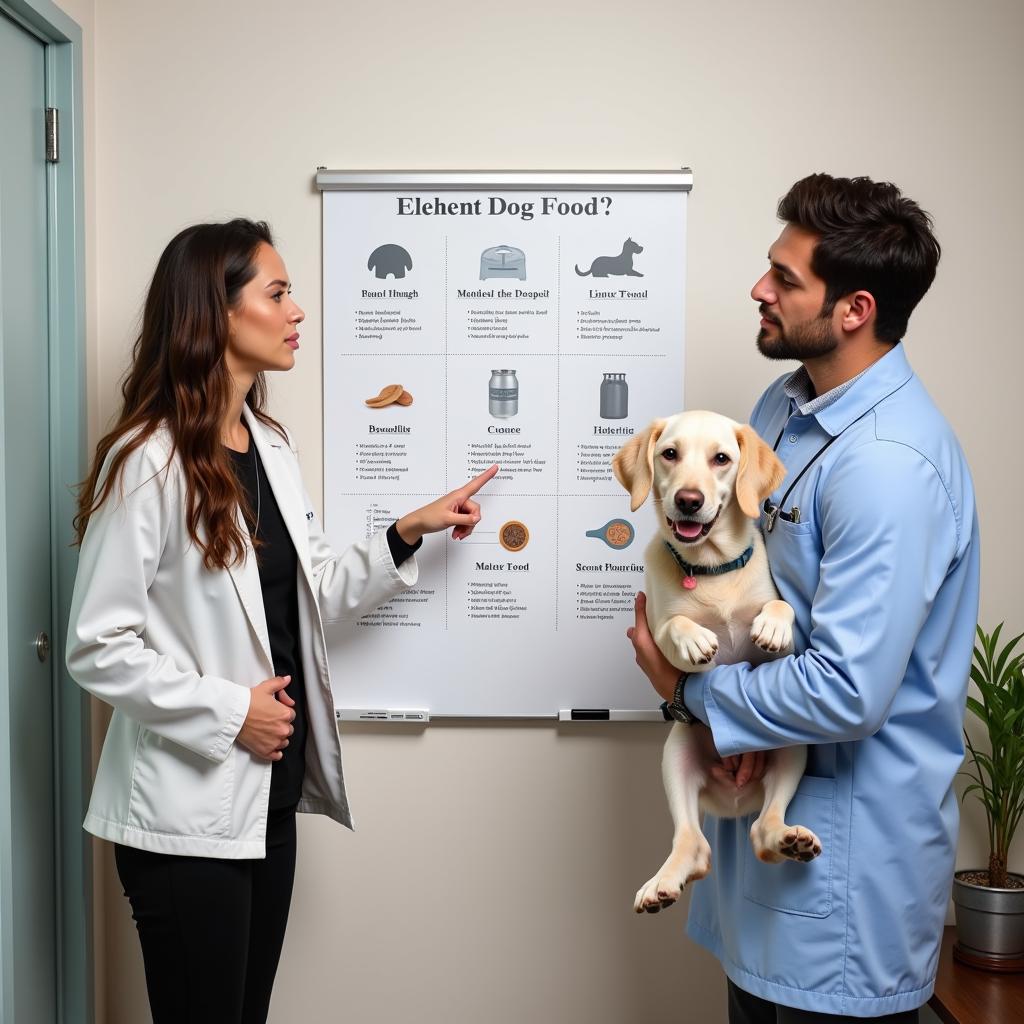Elemental Dog Food has been gaining traction among pet owners for its unique approach to canine nutrition. But what exactly is it, and how can it benefit your furry friend? This comprehensive guide will delve into the world of elemental diets for dogs, exploring their benefits, potential drawbacks, and everything in between.
 A Close-up of Elemental Dog Food Ingredients
A Close-up of Elemental Dog Food Ingredients
Understanding Elemental Dog Food: A Breakdown
Unlike traditional dog foods that use whole proteins and complex carbohydrates, elemental dog food breaks down these nutrients into their simplest, most digestible forms. This means instead of chicken or beef, you’ll find amino acids; instead of rice or potatoes, you’ll see simple sugars.
This predigested form aims to minimize the workload on your dog’s digestive system, making it easier for them to absorb essential nutrients. This can be particularly beneficial for dogs with food sensitivities, allergies, or gastrointestinal issues.
Who Can Benefit from Elemental Dog Food?
While any dog could technically consume elemental food, it’s often recommended for specific health conditions.
- Food Allergies and Sensitivities: Elemental diets eliminate common allergens found in traditional dog food, providing relief for itchy skin, digestive upset, and other allergy symptoms.
- Inflammatory Bowel Disease (IBD): By reducing digestive inflammation, elemental diets can help manage IBD symptoms and improve nutrient absorption.
- Exocrine Pancreatic Insufficiency (EPI): Dogs with EPI struggle to digest fats and proteins. Elemental diets provide these nutrients in a pre-digested form, aiding in better absorption.
Choosing the Right Elemental Dog Food for Your Canine Companion
Selecting the right elemental diet requires careful consideration and often involves consulting your veterinarian.
- Prescription vs. Over-the-Counter: Some elemental diets require a veterinarian’s prescription, while others are available over-the-counter. Your vet can recommend the best option based on your dog’s needs.
- Ingredients: Scrutinize the ingredient list, ensuring it meets your dog’s specific dietary needs and avoids potential allergens.
- Life Stage: Choose a formula designed for your dog’s age and life stage (puppy, adult, senior).
- Palatability: Transitioning to a new food can be tricky. Look for palatable options or consider mixing the elemental food with your dog’s current food gradually.
 Veterinarian Discussing Elemental Dog Food Options with a Pet Owner
Veterinarian Discussing Elemental Dog Food Options with a Pet Owner
Transitioning to an Elemental Diet: A Gradual Approach
Switching your dog to an elemental diet should be a gradual process to minimize digestive upset.
- Start with Small Amounts: Begin by mixing a small quantity of the elemental food with your dog’s regular food.
- Gradually Increase the Ratio: Over 7-10 days, steadily increase the proportion of elemental food while decreasing the regular food.
- Monitor Your Dog Closely: Watch for any signs of digestive issues like vomiting, diarrhea, or loss of appetite.
Addressing Potential Concerns: Myths and Realities
There are some common misconceptions surrounding elemental dog food.
- “Elemental Diets are Only for Sick Dogs”: While beneficial for specific health conditions, they can also be suitable for healthy dogs with sensitive stomachs or dietary restrictions.
- “Elemental Diets are Boring and Tasteless”: Many brands prioritize palatability, offering various flavors and textures to entice picky eaters.
- “Elemental Diets are Expensive”: The cost can be higher than conventional dog food, but the potential health benefits and vet cost savings can outweigh the initial investment.
The Long-Term Impact: Monitoring and Adjustments
Once your dog has successfully transitioned to an elemental diet, it’s crucial to monitor their progress.
- Regular Vet Checkups: Regular vet visits ensure the diet effectively addresses your dog’s health needs.
- Adjustments: Your veterinarian may suggest adjustments to the diet based on your dog’s response, such as changing the protein source or adjusting the feeding amount.
 A Happy and Healthy Dog Enjoying a Bowl of Elemental Food
A Happy and Healthy Dog Enjoying a Bowl of Elemental Food
In Conclusion: A Personalized Approach to Canine Nutrition
Elemental dog food presents a unique approach to nourishing your furry companions, especially those with specific dietary needs or health concerns. While it’s not a one-size-fits-all solution, understanding its benefits, potential drawbacks, and proper implementation can significantly impact your dog’s overall well-being. Always consult with your veterinarian to determine if an elemental diet aligns with your dog’s individual health and dietary requirements.
Frequently Asked Questions about Elemental Dog Food
1. How long should my dog stay on an elemental diet?
The duration depends on the underlying health condition and your dog’s response to the diet. Your veterinarian will guide you on the appropriate length of time.
2. Can puppies eat elemental dog food?
Yes, there are specific elemental formulas designed to meet the nutritional needs of growing puppies.
3. Is elemental dog food complete and balanced?
Yes, reputable elemental dog food brands formulate their products to be complete and balanced, providing all the essential nutrients your dog requires.
4. Can I make elemental dog food at home?
Creating a balanced and complete elemental diet at home can be challenging and may not be recommended. Commercial options are formulated with precise nutrient profiles.
5. What should I do if my dog doesn’t like the taste of elemental food?
Try different flavors or textures, warm the food slightly, or mix it with a small amount of wet food to enhance palatability.
For further assistance, please contact our dedicated customer support team at Phone Number: 02437655121, Email: minacones@gmail.com or visit our address: 3PGH+8R9, ĐT70A, thôn Trung, Bắc Từ Liêm, Hà Nội, Việt Nam. We have a 24/7 customer service team.